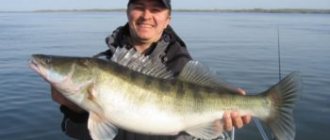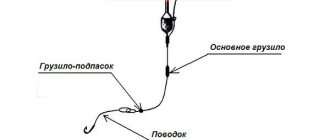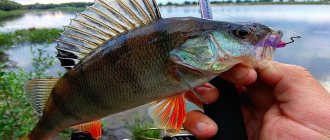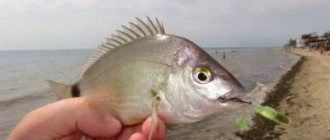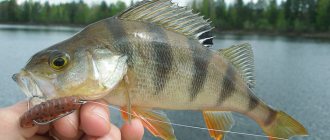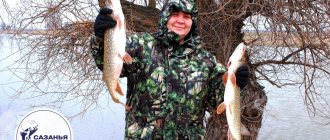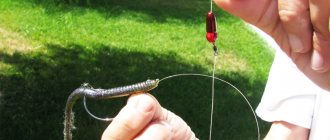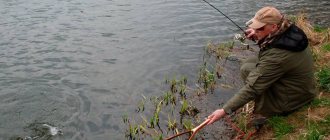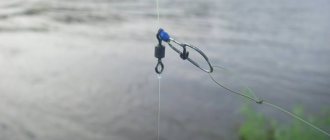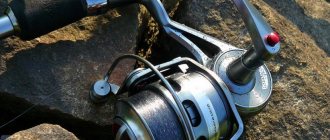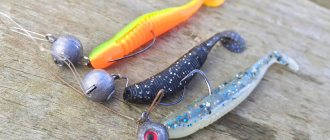A retractable leash (Moscow rig) is a type of spaced spinning rig for catching predatory fish species using soft jig baits. It consists of 2 parallel sections of fishing line of different lengths (most often 20 cm and 100 cm), at the ends of which a sinker and an offset hook with bait are placed, respectively.
In this article you will learn how to tie a diverter leash for fishing for pike, perch and pike perch, chub and asp in the classic version and with 6 modifications. Thanks to the diagram in the photo and step-by-step instructions, you will save time on installing this popular equipment for spinning fishing.
How to properly tie a diverter leash
You will need:
- A “drop” or other elongated sinker, weighing from 5 to 15 g, depending on the depth, strength of the current and the desired casting distance.
- Main line: braided, for example 0.12 mm.
- Leash 120 cm long made of fluorocarbon. The thickness of the fluorocarbon line is 0.25-30 mm. The increased thickness of fluorocarbon is due to the fact that its breaking load is significantly lower than braids and monofilaments.
- The offset hook is adjusted to the size of the fish's mouth.
Drop-shaped sinker (in this case with a swivel) Braided line Fluorocarbon leader line Sunline Siglon FC Offset hook with a curved shank
Instructions for tying the simplest equipment:
- Tie a drop-shaped sinker (possibly with a swivel) to the end of the main braided line using any convenient knot, I use a Double Clinch or an American Knot.
- Tie a fluorocarbon leash 20 cm above the sinker with a Figure Eight knot.
- Tie an offset hook (Double Clinch, American, Grinner, or a hook tie knot) to the end of a 1 m long fluorocarbon leader.
- Equip the offset hook with a twister. This must be done in such a way that the twister is positioned very evenly in the water, which will guarantee a good play of its tail. When you are already on the pond, before making your first requests, be sure to check how the twister behaves in the water; it should not squint to the side or spin. The body should move in the water exactly in a straight line, and the tail should actively play. If there are any problems, transplant the twister, or replace it with a brighter one.
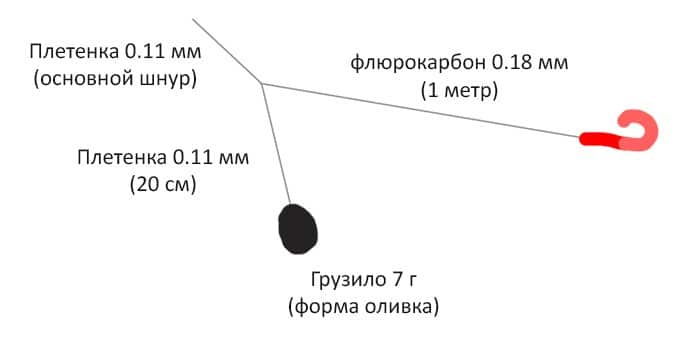
Why is a retractable leash so good? Rigging with such a long lead allows your bait to move more smoothly in the water. While classic jig rigs quickly burrow into the silt and move too sharply, the bait on a retractable leash moves very smoothly and slowly sinks to the bottom, which allows more passive predatory fish to make their hesitant bite.
Advantages of a curler
The biggest advantage of this equipment, based on the results of its use on the water, is that the retractable leash practically does not get confused with the sinker (It is impossible to avoid this by simply tying the leash and braid; already on the third to fifth cast, the junction of the leash, braid and sinker is no longer possible to untangle).
This is due to the fact that when casting, the crease hook and the attached sinker are at an angle of approximately 60 degrees to the main line. When casting, sometimes it still gets tangled, but firstly, it’s rare (about 1 cast out of 10), and secondly, it’s not difficult to untangle, often you just need to unwind the loop of the leash.
And here’s what you need to know: Features of summer fishing for carp, fishing for carp in summer
Another plus. When biting, the fish does not feel the sinker at all, since it hangs on a movable joint. That is, the most careful bite will be directly transmitted to the tip of the spinning rod and into the hand, while the fish will not sense the catch ahead of time.
And one more plus. You can very quickly switch from one rig to another without tying knots in the water. When hooked, the leash breaks from the fishing line, everything else is in place.
Modifications
There are several ways to upgrade a diverter leash, giving it new properties and capabilities that can give an advantage in difficult fishing conditions (grass, snags, deep bottom, strong currents, shifting silt).
You can either lengthen or shorten the length of the leash. This should be done if you come across too passive or too active fish biting. The more passive the fish, the longer the leash is needed. And vice versa, if you feel that perch, pike, pike perch are making very confident bites, but not very often, you can shorten the leash, which can provoke even greater interest from the predator. However, the main point of this rig is to catch passive predatory fish.
Transforming a twister into a suspender. Suspenders are wobblers with a neutral type of buoyancy; baits with this property do not sink or float. You can achieve the same effect from your twister on a retractable leash. This is done by implanting foam balls into your silicone bait or placing foam balls on an offset hook.
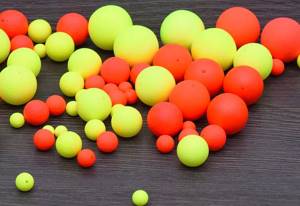
Insertion of a triple swivel at the point where the leash branches from the main braid.
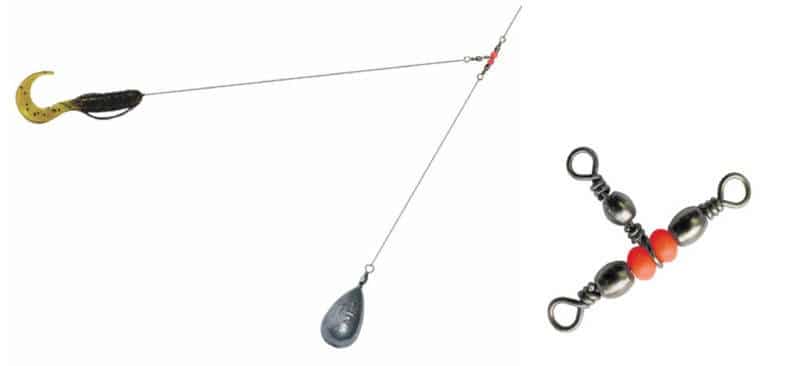
Sliding retractable leash (with two swivels). The sinker in this installation is sliding.

Replacing the sinker with a jig head with a twister. But it is worth considering that this is an unsportsmanlike improvement, since according to the law you cannot fish with 2 hooks in one tackle.
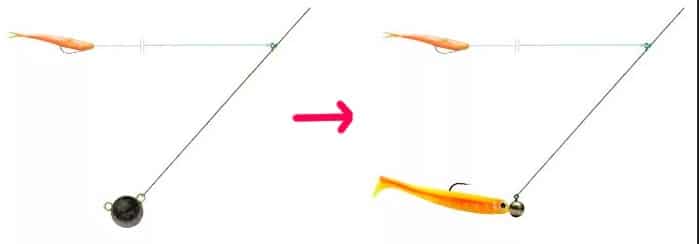
Supplementing a fluorocarbon leash with Kevlar or braid (against the teeth of pike and zander).
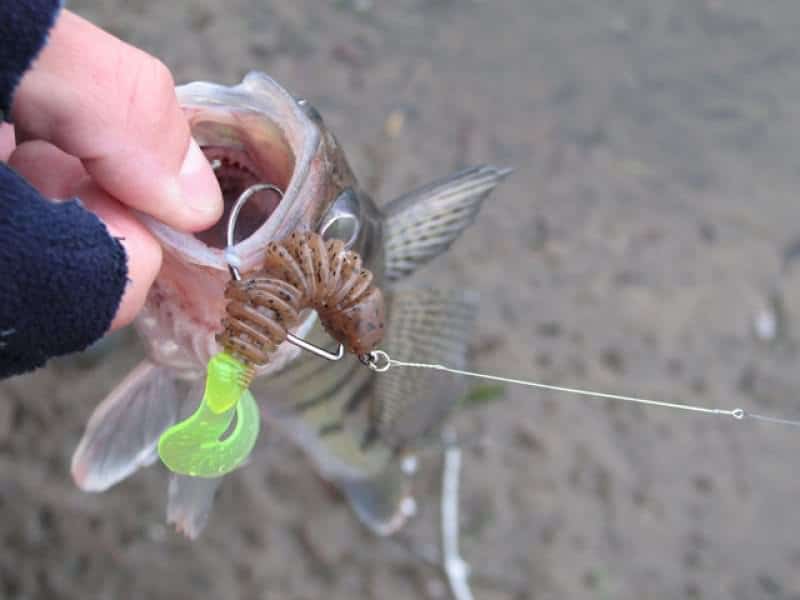
To prevent the lead leash from getting tangled, there are 2 tips:
- Make sure you use fluorocarbon. This is a hard line material that moves the leader well to the side.
- Tie the leader so that the line comes out of the knot towards the rod, not towards the sinker. This will create an additional bend, which also allows you to move the bait to the side.
- Make the segment with the load shorter. If you are confused with the 20 cm segment, try 15 or 10 cm.
Options for using creasers when fishing.
While fishing with a creasing rod, I noted only one drawback to its constant use. If you are fishing with a jig, then when casting, you can wind the line only under the upper swivel to the tulip (no closer than 5-10cm). That is, taking into account the length of the leash, the release when casting is at least 50-60cm.
Another thing you need to pay attention to is that if the creasing rod is installed, and you are fishing with a classic jig, the clasp on the creasing rod needs to be fastened, otherwise it will catch on everything it encounters. Well, weight, of course, also affects. Although 1 gram of leash is not critical, already on a jig it is 6-8 grams.
And here’s what you need to know: THE MOST expensive spinner – Everything is just the MOST!
How to fish with this rig
The retractable leash is a jig rig, which means that fishing will be done at the bottom and you will have to use the most popular jig wiring - stepped.
In the guide to spinning for beginners, we already told you how to make the correct spinning casts and mentioned step retrieving. Your task is to cast to promising places, wait until the sinker hits the bottom, make a small jerk and start reeling in the line. The wiring should be intermittent according to the pattern of 2 turns with the handle, then wait until the sinker falls to the bottom again, then again two turns. The number of revolutions and waiting time between reelings is purely individual and depends on the fishing activity of the fish and your baits. Try changing the speed, number of turns and time between reels to find the ideal activity of your lure at that moment.
Here are some popular step wiring diagrams:
- 2 very fast revolutions, wait until the sinker hits the bottom, then 2 fast revolutions again
- half a turn, wait, half a turn, wait and so on
- 4 turns of medium speed, waiting to fall to the bottom, again 4 turns of medium speed and so on
As you can see, there are a lot of stepped wiring schemes, experiment. Different schemes will work each time.
We purposefully catch one type of fish
| Pike | Hide the tip of an offset hook in a twister and fish in more overgrown places. This tactic will allow your bait to cling to the grass less often. In summer, more often in shallow water, in autumn in deep water. Article about twisters for pike. |
| Perch | Use smaller twisters (up to 3-4 cm) and small offset hooks up to 2 cm in length. This will allow you to catch small perch. And also count on bites from larger individuals. Too large twisters and offset hooks do not allow the perch to swallow the bait and there will be many idle bites. |
| Zander | Catching pike perch with a retractable leash occurs at great depths. You will need a larger jig head (depending on current strength and depth), but I don't think you can use jig heads larger than 20g. Experiment with 8-15g. Use medium sized twisters. |
Seasonal features
| in spring | The closer it gets to summer, the more often the predator will appear in shallow water. While the water is cold, use weights of 10 g and fish depths of 2-3 m. Use bright colors of twisters and vibrotails. The water is cloudy, making it harder for fish to see pale colors. |
| In summer | Bad time to catch pike perch. It begins to actively peck only in August. In hot weather, perch and pike bite only in the early morning hours and before sunset. |
| in autumn | Early spring is the best time to catch pike perch. And right up to frost, pike begin to bite more and more actively. Gradually descending into ever deeper places. |
| in winter | Winter is not the most promising time for a spinner. You can try to catch all predators on non-freezing rivers with strong currents. |
The best rubber for a lead lead
Most often, this equipment includes a twister, and not a vibrating tail. But the second one is also popular, especially some models. Let's look at the example of specific fish.
Large perch require twisters and vibrotails with active play.
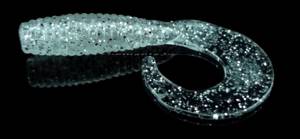
Twister Crazy Fish Angry Spin 2
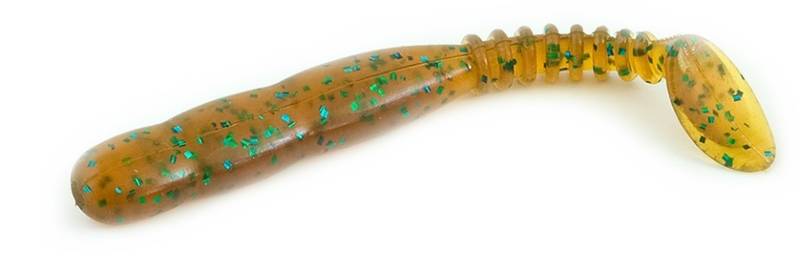
Vibrating tail Reins Rockvibe Shad 2
For pike , the longer size of the bait and its thickness are important. The more amplitude the vibrations of the tail, the better. Therefore, we will not show vibrating tails.

Twister Pontoon 21 Homunculures Hightailer
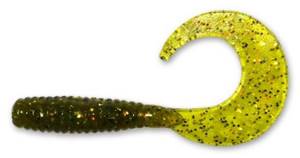
Twister Crazy Fish Angry Spin 2
Pike perch loves long silicone baits and vibrating tails with a thin body and a small tail. They are ideal for a retractable leash.
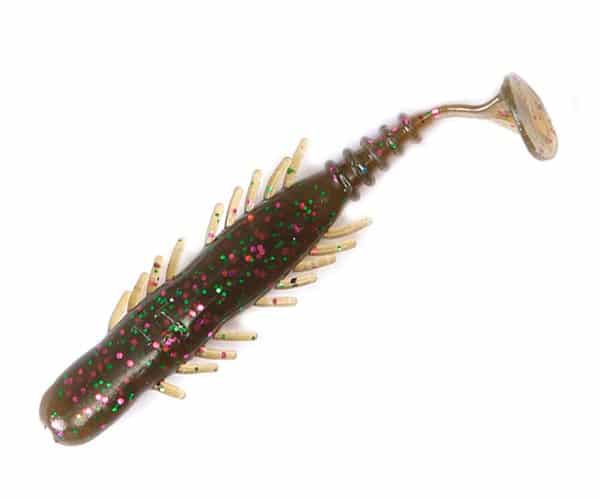
Vibrating tail Bugsy Shad 72
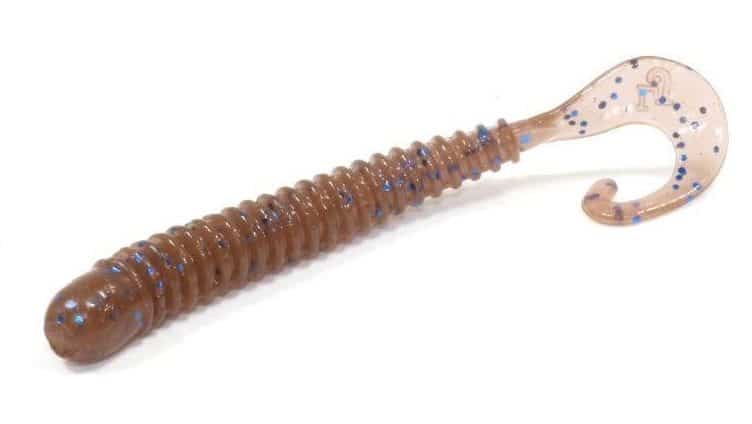
Twister Lucky John Ballist 63
Features of catching perch, pike perch and pike on a retractable leash
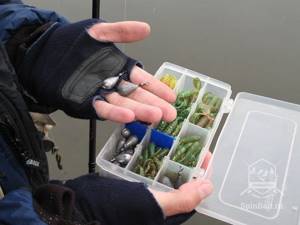
The main difference is a lighter rod, a smaller diameter of the main cord and lead, and the absence of a steel lead in front of the hook. It is recommended to perform the hooking with a slight delay, and the landing must be done evenly, avoiding slack. There is no special pike wiring. Arriving at a pond, the fisherman begins to experiment. Changes baits, uses the types of retrieves known to him, casts with, against, or across the current. But there are still some features. If there is a possibility of catching a pike, then the diameter of the cord and leash should be slightly increased, the length of the lead is slightly reduced and Kevlar or steel leashes must be used. It is better to take a stiffer rod, and you will have to hook sharper, with good amplitude and without waiting.
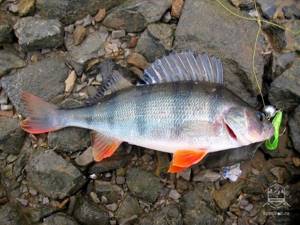
It is not for nothing that pike perch is considered an active predator only conditionally; provoking it to attack can be very difficult. And its habitats, littered areas of the bottom, snags and stones, make its capture difficult. In addition to durable tackle that can withstand vigorous hooking, the use of an offset hook is mandatory. Of great importance is not only the correct selection of the color of the bait, but also its balancing. Otherwise, if the silicone rotates, the number of bites decreases sharply or is completely absent.
Thus, we can conclude that catching a predator using a rig with a retractable leash is an alternative in cases where a classic jig is ineffective. And with periodic biting, increase its intensity.
